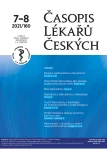Application of telemedicine in cardiology: from ECG monitoring to artificial intelligence
Authors:
Veronika Bulková 1,2; Jakub Pindor 1; Filip Plešinger 1,3; Martin Fiala 1,2
Authors‘ workplace:
Mezinárodní centrum pro telemedicínu MDT, Brno
1; Centrum kardiovaskulární péče, Neuron Medical, Brno
2; Ústav přístrojové techniky AV ČR, Brno
3
Published in:
Čas. Lék. čes. 2021; 160: 317-322
Category:
Review Article
Overview
Telemedicine is one of rapidly developing discipline in current medicine, including cardiology, and specifically cardiac arrhythmias and heart failure. Long-term transtelephonic ECG monitoring has been provided since 2008 in the Czech Republic and other members of EU by International Center for Telemedicine MDT (Medical Data Transfer), with approximately 45 000 monitored individuals per year and mean individual monitoring duration of 14 ± 9 days.
Current home-monitoring of implantable devices is offered by all leading companies with distribution in the Czech Republic (Abbott, Medtronic, Biotronik, Boston Scientific). It enables to follow device parameters as well as get information on detected arrhythmias, and further, through the server set up to automatically process warnings and alarms and to inform the responsible physician via e-mail, fax, or SMS.
All branches of telemedicine work with a huge amount of data difficult to process without the means of artificial intelligence, whose principles and methods are discussed in the article. International Center for Telemedicine in collaboration with the Institute of Scientific Instruments of the Czech Academy of Sciences have developed and employs one such a model for the long-term ECG analysis.
Keywords:
artificial intelligence – Telemedicine – long-term transtelephonic ECG monitoring – home monitoring of implantable devices
Sources
- Furman S, Parker B, Escher DJ, Schweldel JB. Instruments for evaluating function of cardiac pacemakers. Med Res Eng 1967; 6(3): 29–32.
- Kamarýt P, Rícný V, Habán J. Telefonické sledování kmitoctu impulsů implantovaných kardiostimulátorů. Vnitřní lékařství 1979; 25(4): 366–373.
- Ziegler PD, Rogers JD, Ferreira SW et al. Long-term detection of atrial fibrillation with insertable cardiac monitors in a real-world cryptogenic stroke population. Int J Cardiol 2017; 244 : 175–179.
- Hutten H, Schreier G, Kastner P. Cardiac telemonitoring using pacemakers and the Internet. Medical & Biological Engineering & Computing 1999; 35 (Suppl. 2): 1295.
- Burri H, Senouf D. Remote monitoring and follow-up of pacemakers and implantable cardioverter defibrillators. Europace 2009; 11(6): 701–709.
- Tilz RR, Shaik N, Piorkowski C, Hu Y et al. Real-world adoption of smartphone-based remote monitoring using the confirm Rx™ insertable cardiac monitor. J Innov Card Rhythm Manag 2021; 12(8): 4613–4620.
- Gillberg J. Detection of cardiac tachyarrhythmias in implantable devices. J Electrocardiol 2007; 40(6 Suppl.): S123–S128.
- Lipoldová J, Novák M, Dvořák I a kol. Systém Biotronik Home Monitoring v klinické praxi. Cor et Vasa 2011; 53 : 611–618.
- Varma N. Rationale and design of a prospective study of the efficacy of a remote monitoring system used in implantable cardioverter defibrillator follow-up: the Lumos-T reduces routine office device follow-up study (TRUST) study. Am Heart J 2007; 154(6): 1029–1034.
- Crossley GH, Boyle A, Vitense H et al. The CONNECT (Clinical Evaluation of Remote Notification to Reduce Time to Clinical Decision) trial: the value of wireless remote monitoring with automatic clinician alerts. J Am Coll Cardiol 2011; 57(10): 1181–1189.
- Mabo P, Victor F, Bazin P, Ahres S et al. A randomized trial of long-term remote monitoring of pacemaker recipients (the COMPAS trial). Eur Heart J 2012; 33(9): 1105–1111.
- Saxon LA, Hayes DL, Gilliam FR et al. Long-term outcome after ICD and CRT implantation and influence of remote device follow-up: the ALTITUDE survival study. Circulation 2010; 122(23): 2359–2367.
- Hindricks G, Táborský M, Glikson M et al. Implant-based multiparameter telemonitoring of patients with heart failure (IN-TIME): a randomised controlled trial. Lancet 2014; 384(9943): 583–590.
- Abraham A, Pedregosa F, Eickenberg M et al. Machine learning for neuroimaging with scikit-learn. Front Neuroinform 2014; 8 : 14.
- Plešinger F, Nejedlý P, Viscor I et al. Parallel use of a convolutional neural network and bagged tree ensemble for the classification of Holter ECG. Physiol Meas 2018; 39(9): 094002.
- Paszke A, Gross S, Massa F et al. PyTorch: an imperative style, high-performance deep learning library. Article No.: 721. NIPS'19: Proceedings of the 33rd International Conference on Neural Information Processing Systems 2019 Dec: 8026–8037.
- Clifford GD, Silva I, Moody B et al. The PhysioNet/Computing in Cardiology Challenge 2015: Reducing false arrhythmia alarms in the ICU. Comput Cardiol 2015; 2015 : 273–276.
- Moody GB, Mark RG. The impact of the MIT-BIH arrhythmia database. IEEE Eng Med Biol Mag 2001; 20(3): 45–50.
- Vaswani A, Shazeer N, Parmar N et al. Attention is all you need. NIPS'17: Proceedings of the 31st International Conference on Neural Information Processing Systems 2017 Dec: 6000–6010.
- Baltruschat IM, Nickisch H, Grass M et al. Comparison of deep learning approaches for multi-label chest X-ray classification. Sci Rep 2019; 9(1): 6381.
Labels
Addictology Allergology and clinical immunology Angiology Audiology Clinical biochemistry Dermatology & STDs Paediatric gastroenterology Paediatric surgery Paediatric cardiology Paediatric neurology Paediatric ENT Paediatric psychiatry Paediatric rheumatology Diabetology Pharmacy Vascular surgery Pain management Dental HygienistArticle was published in
Journal of Czech Physicians

2021 Issue 7–8
Most read in this issue
- COVID-19, postcovid syndrome and postvaccination complications at neurology outpatient clinic
- Manuál k elektronickému zdravotnictví
- Mitochondria – from origin to current therapies
- Legal framework of telemedicine for provision of healthcare
